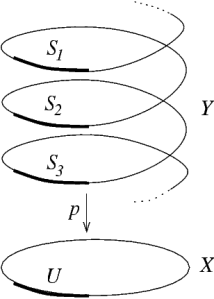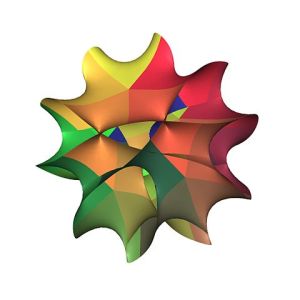In p-adic Hodge Theory: An Overview, we discussed how the different cohomologies of some smooth projective variety over the p-adic numbers (or some finite extension of it) such as its p-adic etale cohomology, de Rham cohomology, or crystalline cohomology can be related to each other via the machinery of period rings.
We note that the theories we have discussed in p-adic Hodge Theory: An Overview are “rational”, in that they involve cohomologies with “rational” coefficients (for instance ). Cohomology with integral coefficients holds some information that gets lost when passing to rational coefficients; for instance, all the information about the torsion is lost. If we want to relate, say, torsion subgroups of different cohomologies to each other, we would need some sort of integral p-adic Hodge theory. In this post, we will discuss one approach to integral p-adic Hodge theory, called prismatic cohomology, developed by Bhargav Bhatt and Peter Scholze.
As a preliminary to defining prismatic cohomology, we briefly discuss the concept of -rings. A
-ring is a ring
together with a map
called a p-derivation, satisfying the following properties:
The concept of -rings were introduced by Andre Joyal, and its theory and that of p-derivations was further developed by Alexandru Buium. This also has connections to the work of James Borger as we discussed in The Field with One Element.
A prism is a pair consisting of a
-ring
an ideal
defining a Cartier divisor on
, such that
is derived
-complete (this means that for every
we have, considering
as a module over itself,
and
) and
.
An example of a prism is given by taking and taking
. Another important example that we will show up again later in this post is given by
and
, where
is the canonical map (see also Perfectoid Fields for a discussion of these concepts).
Prisms are also related to (integral) perfectoid rings (see also Adic Spaces and Perfectoid Spaces). A prism is perfect if the ring
is perfect (i.e. the Frobenius is an automorphism). If
is a perfect prism, then the quotient
is an perfectoid ring. In fact, there is an equivalence of categories between perfect prisms and perfectoid rings, and one can go the other way via the
construction, i.e. given a perfectoid ring
we set
, and there is a canonical map
, and we set
; then the pair
obtained via this construction is a prism.
Remark: The perfectoid rings mentioned in the previous paragraph are related, but not quite the same, as in Adic Spaces and Perfectoid Spaces. The perfectoid rings in the previous paragraph and in the rest of the article correspond to the ring of integral elements of the perfectoid rings in Adic Spaces and Perfectoid Spaces, hence the word “integral”. To match with the references, we will drop the word “integral” in the rest of this post, but perfectoid rings in this post will mean integral perfectoid rings.
Let be a prism and let
be a formally smooth
-algebra. The prismatic site of
relative to
, denoted
, is the category of prisms
over
together with a map from
to
over
. We write such an object as
. We have functors
and
which send
to
and
respectively. We now define the prismatic cohomology of
, denoted
, to be
. As an example, in the special case that
, then the prismatic cohomology
is just
.
Related to prisms and prismatic cohomology is the notion of prismatic crystals. A prismatic crystal is an assignment, given a prism in
, of a finite projective
-module. We also have related notions of Hodge-Tate crystals (which assign finite projective
-modules instead), prismatic F-crystals (prismatic crystals
with an isomorphism
), and notions of crystals where instead of modules we consider complexes (perfect or
-complete) of modules.
The prismatic cohomology is equipped with some other extra structures, for instance we have the notion of a Breuil-Kisin twist
, which corresponds to the Tate twist in etale cohomology. The prismatic cohomology also comes with a filtration, called the Nygaard filtration. These structures are important for some of the applications of prismatic cohomology. For instance, the two notions just discussed allows us to give a definition of syntomic cohomology as follows:
The syntomic cohomology is related to etale K-theory of p-adically complete rings; in particular, there is a motivic filtration on the etale K-theory whose graded pieces are given by shifts of the syntomic cohomology. This relation between etale K-theory and syntomic cohomology goes through the theory of topological cyclic homology (and other related theories such as topological Hochschild homology) and hints at deep connections between prismatic cohomology and algebraic topology; we leave further discussion of these directions to the references or possible future posts.
As mentioned earlier, prismatic cohomology gives us an integral version of p-adic Hodge theory. Therefore, it must be related to the different cohomology theories such as crystalline cohomology and etale cohomology. This relationship is explicitly stated in the form of the following comparison theorems. For crystalline cohomology, we have (in the language of derived categories)
The crystalline cohomology can be considered a “lift” of the de Rham cohomology; namely the de Rham complex that computes the de Rham cohomology of
over
is related to
as follows:
And so we see that prismatic cohomology also computes de Rham cohomology. Meanwhile, for etale cohomology, letting be an element of
such that
(we call such an element
a distinguished element), we have
These comparison theorems of prismatic cohomology can be used to obtain results regarding cohomology with torsion coefficients. For instance, let be a proper formal scheme over
. Let
be the prism given by
and
. Then one can construct the prismatic cohomology
by gluing together the different
for every
, and then use the comparison theorems previously mentioned to prove the following result:
Note that this result involves torsion coefficients, and therefore inaccessible if one does not have an “integral” p-adic Hodge theory.
Another application of ideas from prismatic cohomology is the construction of a p-adic Riemann-Hilbert correspondence by Bhargav Bhatt and Jacob Lurie. The classical Riemann-Hilbert correspondence is an equivalence of derived categories between regular holonomic D-modules and Zariski constructible sheaves, itself an upgrade of a classical equivalence of categories between algebraic vector bundles with regular flat connection (which we may think of as differential equations) and local systems of complex vector spaces (which we may think of as solutions to these differential equations) on a smooth complex algebraic variety.
Bhatt and Lurie have developed a version of the Riemann-Hilbert correspondence for perfectoid spaces, making use of perfected prismatic cohomology, and the way it allows us to construct a “perfectoidization” of a ring. Given any ring, its perfectoidization is an -algebra
which is perfectoid, and such that for any other perfectoid ring
,
. As we just stated, a way to construct the perfectoidization is given by the perfected prismatic cohomology. Let
be perfectoid. We define the following complex:
Now let be a finite
-algebra, and
. The pair
is a perfect prism, and the quotient
is a perfectoidization of
(which we may therefore also denote by
).
Let be an etale morphism. We may express this as the composition
, where
is finite. We may express
and
. Then we can define
If is a perfect
-algebra, then the functor which sends the sheaf
to
may be taken to be a Riemann-Hilbert functor, agreeing with previous constructions of Bhatt and Lurie. Inspired by this, in the more general case we can define
Note that is an
-module, and that
. For an etale morphism
, let
be the sheaf
on
, where
is the constant sheaf of
-coefficients. Sheaves of this form generate the category of abelian sheaves on
. The Riemann-Hilbert functor for perfectoid spaces is then the functor that takes
to
. Bhatt and Lurie have also extended their Riemann-Hilbert functor not only to perfectoid spaces but also to p-adic formal schemes over
.
Bhargav Bhatt has used the p-adic Riemann-Hilbert correspondence to prove new results in commutative algebra and algebraic geometry. For instance, Bhatt has used it (in conjunction with other ideas from prismatic cohomology) to prove the following theorem. Suppose . Let
denote the integral closure of
inside the algebraic closure of its fraction field. Then, for any prime
, the ring
is p-adically Cohen-Macaulay, which explicitly means that for any
,
is a zero divisor of
A “global” version of this theorem is mixed-characteristic Kodaira vanishing up to finite covers, also proved by Bhatt, and which has applications to the minimal model program in birational geometry.
Remark: Bhatt and Lurie have also developed another version of the p-adic Riemann-Hilbert correspondence for varieties over . The methods appear to differ from what has been discussed in this post, instead using a version of the methods developed by Peter Scholze in his work on p-adic Hodge theory for rigid analytic varieties (also very briefly mentioned in The Geometrization of the Local Langlands Correspondence); this version of the p-adic Riemann-Hilbert correspondence has also found applications in algebraic geometry, such as Kollar vanishing.
There is also a “geometrized” version of prismatic cohomology, also developed by Bhatt and Lurie where the prismatic cohomology is obtained from a complex of sheaves on a certain stack called the “Cartier-Witt stack“. The Cartier-Witt stack itself can be generalized (or “relativized”) via the concept of a prismatization of a p-adic formal scheme
(the Cartier-Witt stack is the prismatization
of
). The prismatization
fits into a bigger stack
, the Nygaard filtered prismatization of
, together with another copy of
, and gluing together these two copies results in another stack
called the syntomification of
.
The derived category of quasi-coherent sheaves on is called the category of prismatic F-gauges on
. The theory of prismatic F-gauges is related to the theory of Galois representations. For instance, the etale realization of a coherent sheaf on
, upon inverting
, is a crystalline Galois representation. The theory also allows us to refine Tate duality for Galois representations. Together, these facts can be used to show that the image of such a coherent sheaf in Galois cohomology is the Bloch-Kato Selmer group, which is a very important object in the theory of L-functions and modularity.
Prismatic cohomology has shown itself to have very many interesting aspects which are currently the subject of much ongoing research. We have only given a very shallow overview of the theory in this post. We leave a list of references for the interested reader for further reading, but also hope to discuss more details of this rapidly growing theory in more depth in future blog posts.
References:
Prisms and Prismatic Cohomology by Bhargav Bhatt and Peter Scholze
Geometric Aspects of p-adic Hodge Theory (notes by Chao Li from a course by Bhargav Bhatt)
Prismatic Cohomology by Bhargav Bhatt
Notes on Prismatic Cohomology by Kiran Kedlaya
Algebraic Geometry in Mixed Characteristic by Bhargav Bhatt
A Riemann-Hilbert Correspondence in p-adic Geometry by Jacob Lurie (2022 Felix Klein Lectures)
Prismatic F-Gauges by Bhargav Bhatt
Absolute Prismatic Cohomology by Bhargav Bhatt and Jacob Lurie
The Prismatization of p-adic Formal Schemes by Bhargav Bhatt and Jacob Lurie
Prismatic / THH Reading List by Yuri Sulyma




